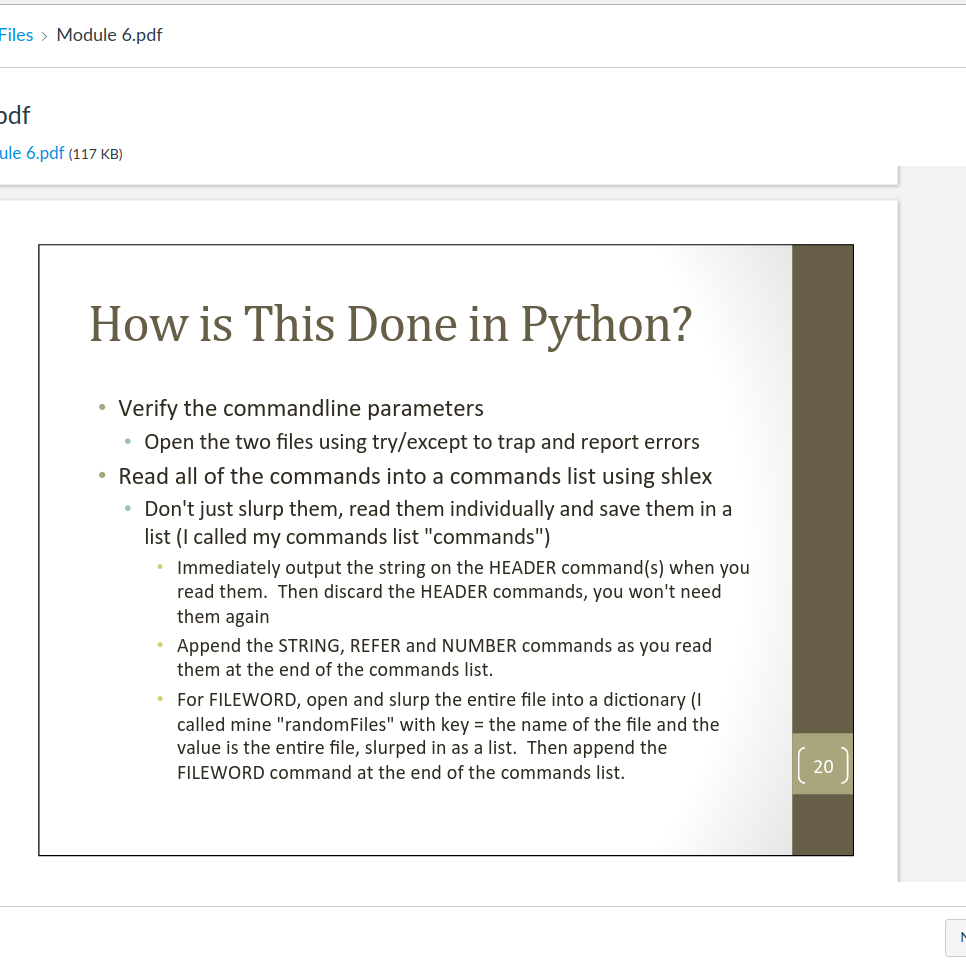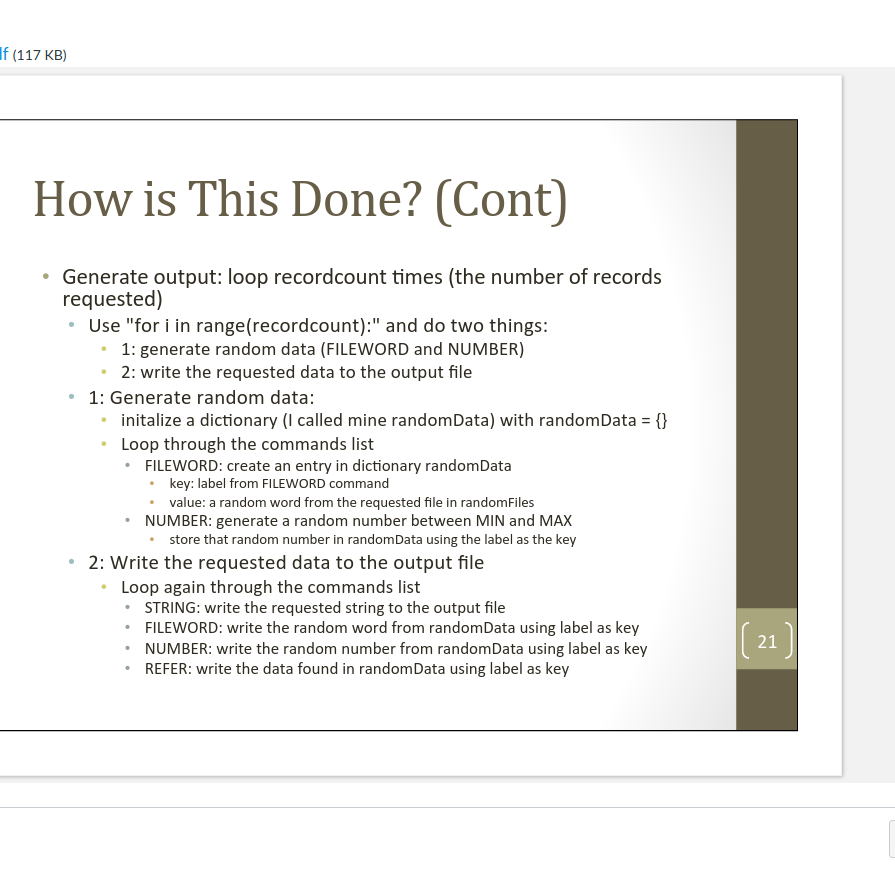Question
I need python help .. I need to know if a user were to input 3 commands to a program and run it such as
I need python help .. I need to know if a user were to input 3 commands to a program and run it such as specify: Usage: ./filemaker INPUTCOMMANDFILE OUTPUTFILE RECORDCOUNT (./filemaker is the program)( (INPUTCOOMANDFUILE= a text file that contains key words that need to be searched through then decided what to do ) (RECORDCOUNT= number)
This is what I need to do: Given an input file that contains the following:
for example: Scenario: Script outputs the correct number of records Given a file named "smallcmd" with: """ STRING "hello, world! " """ When I run `../bin/filemaker smallcmd smalloutput 3` Then the file "smalloutput" should contain: """ hello, world! hello, world! hello, world! """
What i need is for the python program to be able to search the text file, and put it either in a list or a dictionary or both.. It needs to search that file for the if the KEYWORD "STRING" is in that file.. if it is it then needs to match the output that i have shown print only the letters or string that comes after that keyword.. in this case since the user entered the number 3 it has to loop that 3 times.. exactly as the input shows.. please make sure that the output is sent to a textfile
I need python help .. I need to know if a user were to input 3 commands to a program and run it such as specify: Usage: ./filemaker INPUTCOMMANDFILE OUTPUTFILE RECORDCOUNT (./filemaker is the program)( (INPUTCOOMANDFUILE= a text file that contains key words that need to be searched through then decided what to do ) (RECORDCOUNT= number)
This is what I need to do: Given an input file that contains the following:
for example: Scenario: Script outputs the correct number of records Given a file named "smallcmd" with: """ STRING "hello, world! " """ When I run `../bin/filemaker smallcmd smalloutput 3` Then the file "smalloutput" should contain: """ hello, world! hello, world! hello, world! """
What i need is for the python program to be able to search the text file, and put it either in a list or a dictionary or both.. It needs to search that file for the if the KEYWORD "STRING" is in that file.. if it is it then needs to match the output that i have shown print only the letters or string that comes after that keyword.. in this case since the user entered the number 3 it has to loop that 3 times.. exactly as the input shows.. please make sure that the output is sent to a textfile Thanks please ask me to clarify anything
Please read all of the insutrctions . I will do my best to explain what is needed. Must be written in python.
-Objective: read a le of commands and output a number of records that matches those commands. In a sense, you are writng a simple command interpreter.
Usage: ./lemaker ( this is what the user will enter, a file that will containt a text document, then they will have an outputfile and a number that will be used for determing what to do with the output.
- The program needs to be able to search the text file and find a key word and then process that information depending on that key ( Correct Number of records, HEADER command, STRING command,FILEWORD command)
Here are the files that will be passed in by the user and then the output file must match
for example: Scenario: Script outputs the correct number of records Given a file named "smallcmd" with: """ STRING "hello, world! " """ When I run `../bin/filemaker smallcmd smalloutput 3` Then the file "smalloutput" should contain: """ hello, world! hello, world! hello, world! """
or
Scenario: Script supports the HEADER command Given a file named "headercmd" with: """ HEADER "This is a header with an imbedded tab character " STRING "just a string " """ When I run `../bin/filemaker headercmd headeroutput 2` Then the file "headeroutput" should contain: """ This is a header with an imbedded tab character just a string just a string """ or Scenario: Script supports the STRING command Given a file named "anotherstringcmd" with: """ STRING "yet another string " """ When I run `../bin/filemaker anotherstringcmd anotherstringoutput 3` Then the file "anotherstringoutput" should contain: """ yet another string """
or Scenario: Script supports the FILEWORD command Given a file named "filewordcmd" with: """ FILEWORD filelabel "words" """ Given a file named "words" with: """ one two three four five """ When I run `../bin/filemaker filewordcmd filewordoutput 1` Then the file "filewordoutput" should match /one|two|three|four|five/
or
Scenario: Script supports the NUMBER command Given a file named "numbercmd" with: """ NUMBER numlabel 1 1999 STRING " " """ When I run `../bin/filemaker numbercmd numberoutput 3` Then the file "numberoutput" should match /^\d+ \d+ \d+ /
or Scenario: Script supports the REFER command to a label on a FILEWORD command Given a file named "morewords" with: """ this is a test """ Given a file named "referfilewordcmd" with: """ FILEWORD flabel "morewords" STRING " and " REFER flabel STRING " and " REFER flabel """ When I run `../bin/filemaker referfilewordcmd referfilewordoutput 1` Then the file "referfilewordoutput" should match /^(\w+) and \1 and \1$/ expected "\"\" morewords \"\"\" " to match /^(\w+) and \1 and \1$/ or
Scenario: Script supports the REFER command to a label on a NUMBER command Given a file named "refernumbercmd" with: """ NUMBER numlabel 1 99999 STRING " I said " REFER numlabel STRING " I said " REFER numlabel """ When I run `../bin/filemaker refernumbercmd refernumberoutput 1` Then the file "refernumberoutput" should match /^(\d+) I said \1 I said \1$/ expected "\"\" \"\"\" " to match /^(\d+) I said \1 I said \1$/


Step by Step Solution
There are 3 Steps involved in it
Step: 1

Get Instant Access to Expert-Tailored Solutions
See step-by-step solutions with expert insights and AI powered tools for academic success
Step: 2

Step: 3

Ace Your Homework with AI
Get the answers you need in no time with our AI-driven, step-by-step assistance
Get Started


